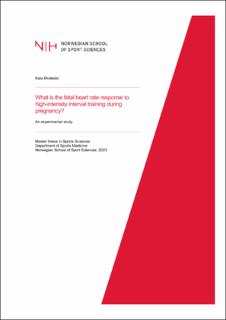| dc.description.abstract | Background: In the current literature it is established that exercise at moderate intensity during pregnancy is safe and provides several health benefits for the mother and fetus. However, few studies have investigated the health impact and safety of exercise at high intensity, yielding inconclusive results. Fetal heart rate (FHR) is an important outcome when investigating fetal health, as this is one indication of the fetus being well oxygenated. Fetal tachycardia (FHR >160 bpm) can be expected during exercise, as FHR is known to increase during maternal exercise. Fetal bradycardia (FHR<110 bpm) may be associated with conditions such as maternal hypotension, umbilical cord compression and fetal heart abnormalities.
Objective: The aim was to examine the FHR response to maternal high-intensity interval training and investigate if FHR response varied based on exercise mode.
Method: This was an experimental study on pregnant frequent exercisers and elite athletes during gestational week 26 to 35. Participation included treadmill running and stationary bicycling in five-minute intervals, for up to five intervals. Target intensity was 90% of estimated maximal heart rate and rate of perceived exertion at 17 on Borg´s scale. FHR was measured using color Doppler ultrasound after each interval.
Results: Among the 18 participants performing treadmill running (17 frequent exercisers and one elite athlete), we observed five cases of fetal bradycardia, two of which were sustained (>3min). Among the 20 participants performing stationary bicycling (17 frequent exercisers and three elite athletes), three cases of fetal bradycardia were observed, two of which were sustained. There were 12 cases of fetal tachycardia during treadmill running, and 16 during stationary bicycling.
Conclusion: Most fetuses in well-trained pregnant women demonstrated good tolerance to high-intensity interval training, reaching up to approximately 90% of maximal heart rate and a rate of perceived exertion of 17 on Borg´s scale. Treadmill running resulted in higher occurrence of fetal bradycardia compared to stationary bicycling. This distinction could be attributed to consistently higher levels of intensity achieved during this exercise mode. | en_US |
